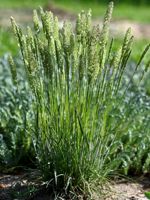Mon-Fri 9am - 5pm Mountain time
Junegrass vs Pearly Everlasting
Koeleria macrantha
Anaphalis margaritacea
NOT AVAILABLE THIS SEASON - MIGHT RETURN
CUSTOM GROW
Junegrass is a native, low-growing perennial bunchgrass commonly found in prairies and open woodlands. It is a great choice for prairie restoration and naturalization projects or an attractive accent in ornamental plantings. Spear-shaped seed heads rise above the gray-green lower leaves, maturing to a tan color. Flowering earlier than other upright prairie grasses, it greens up quickly in spring and maintains its appeal well into the fall. It is shorter in stature and rarely forms thick stands, which adds to its understated visual appeal.
Adapted to cooler climates, Junegrass thrives in well-drained, rocky, sandy, or gritty soils and can tolerate drought, cold, and high altitudes. It actively grows in spring and fall when soil temperatures are cool, but in areas that are too hot or humid, it may go dormant by late summer.
As a perennial, it dies back to the crown each winter, it will regrow from the base in the spring. Avoid disturbing the crown during late winter to ensure healthy growth the following season.
Pearly Everlasting is a native perennial wildflower known for its clusters of white, papery flowers with yellow centres. These long-lasting blooms appear throughout summer, and the silver-grey foliage adds contrast to the landscape. Its nectar supports a variety of pollinators and serves as a host plant for painted lady caterpillars.
Pearly Everlasting is also used in dried flower arrangements. It is well-suited for pollinator gardens, naturalization, ecological restoration, and low-maintenance landscapes.

